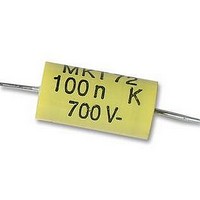26231941 Crouzet USA, 26231941 Datasheet - Page 19

26231941
Manufacturer Part Number
26231941
Description
CAPACITOR, MOTOR MEDIUM TORQUE CAPACITOR, MOTOR MEDIUM TORQUE
Manufacturer
Crouzet USA
Datasheet
1.26231909.pdf
(196 pages)
Specifications of 26231941
Capacitance
0.1UF
Voltage Rating, Dc
700V
Capacitor Dielectric Type
POLYPROPYLENE
Tolerance,
10%
Tolerance, -
10%
Temp, Op. Max
85(DEGREE C)
Temp, Op. Min
0(DEGREE
- Current page: 19 of 196
- Download datasheet (6Mb)
➜ Torque and speed of rotation
The torque generated by the motor, and its speed of rotation, are
dependent on each other.
This is a basic characteristic of the motor ; it is a linear relationship and is
used to calculate the no-load speed and the start-up torque of the motor.
The curve for the output power of the motor is deduced from the graph of
torque versus speed.
Pu (W) = 2
Output
power
The torque vs. speed and output power curves depend on the supply
voltage to the motor.
The supply voltage to the motor assumes continuous running of the motor
at an ambient temperature of 20°C in nominal operational conditions.
It is possible to supply the motor with a different voltage (normally
between -50% and + 100% of the recommended supply voltage).
If a lower voltage is used compared to the recommended supply the
motor will be less powerful.
If a higher voltage is used, the motor will have a higher output power but
will run hotter (intermittent operation is recommended).
For variations in supply voltage between approximately - 25% to + 50%,
the new torque vs. speed graph will remain parallel to the previous one.
Its start-up torque and no-load speed will vary by the same percentage
(n%) as the variation in supply voltage. The maximum output power is
multiplied by (1 + n%)
Example : For a 20% increase in supply voltage
Output power
Motor Torque
Start-up torque increases by 20% ( x 1.2)
No-load speed increases by 20% ( x 1.2)
Output power increases by 44% ( x 1.44)
Start Torque
Maximum Power
60
Motor
torque
x C (N.m) x N (rpm)
1/2 Speed
(no load)
2
.
Speed of
rotation
Speed (no load)
Speed
(no load)
Rotation speed
Rotation speed
➜ Torque and supply current
This is the second important characteristic of a D.C. motor.
It is linear and is used to calculate the no-load current and the current
with the rotor stationary (start-up current).
The graph for this relationship does not vary with the supply voltage of
the motor. The end of the curve is extended in accordance with the torque
and the start-up current.
The gradient of this curve is called the «torque constant» of the motor.
This torque constant is such that :
The «rotational friction torque» is Kc Io.
The torque is therefore expressed as follows :
Kc = Torque constant (Nm/A)
C = Torque (Nm)
Cd = Start-up Torque (Nm)
Cf = Rotational friction torque (Nm)
I
Io = No-load current (A)
Id = Start-up current (A)
The graph of torque vs. current and torque vs. speed is used to determine
the absorbed power as a function of the speed of rotation of the motor.
➜ Efficiency
The efficiency of a motor is equal to the mechanical output power that it
can deliver, divided by the power which it absorbs.
The output power and the absorbed power vary in relation to the speed
of rotation, therefore the efficiency is also a function of the speed of the
motor.
Maximum efficiency is obtained with a given rotational speed greater than
50% of no-load speed.
Power (W)
Motor Torque (N.m)
= Current (A)
Current (no load)
Start Torque
Output
power
Output power
(no load)
C = Kc I - Cf with Cf = Kc Io
C = Kc (I - Io)
Starting
Current
Kc =
rpm
Efficiency
Id - Io
Cd
Max. power
Current (Amps)
Speed (no
load)
rpm
19
1
Related parts for 26231941
Image
Part Number
Description
Manufacturer
Datasheet
Request
R

Part Number:
Description:
SCREW SOCKET (OT08PC)
Manufacturer:
Crouzet USA
Datasheet:

Part Number:
Description:
PANEL PLATE FOR 813
Manufacturer:
Crouzet USA
Datasheet:

Part Number:
Description:
Controller; CTD46 Dual Display Temperature, 1/16 DIN, NEMA 4X, 110/220VAC
Manufacturer:
Crouzet USA
Datasheet:

Part Number:
Description:
11R1084
Manufacturer:
Crouzet USA
Datasheet:

Part Number:
Description:
11R1086
Manufacturer:
Crouzet USA
Datasheet:

Part Number:
Description:
11R1087
Manufacturer:
Crouzet USA
Datasheet:

Part Number:
Description:
11R1089
Manufacturer:
Crouzet USA
Datasheet:

Part Number:
Description:
11R1078
Manufacturer:
Crouzet USA
Datasheet:

Part Number:
Description:
11R1079
Manufacturer:
Crouzet USA
Datasheet:










